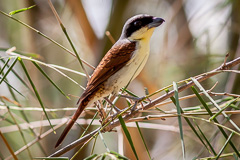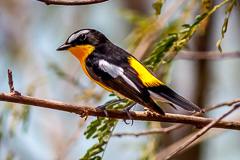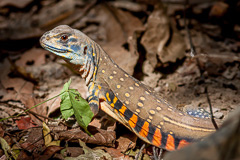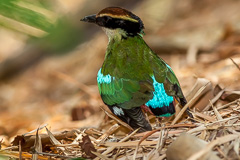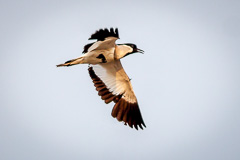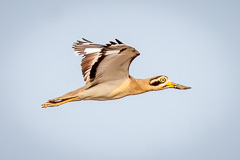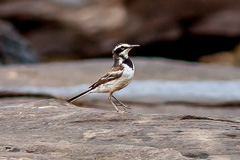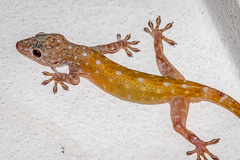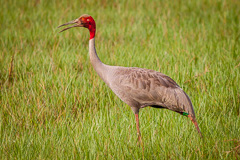Overview
Dates: |
18 -24 April 2014. |
With Ian Dugdale and Games Punjapa Phetsri. With increasing knowledge of where and how to look for Mekong Wagtail coming to light over the past couple of years, we'd been planning to do this trip for some time. The timing was chosen to coincide with the end of the dry season, when the Mekong river level would be low, together with the attraction of visiting the Man Islands at potentially the peak of the Spring migration. This trip involved a lot of driving. 17 Apr. Took Bangkok Airways midday to Bangkok, met up with Ian and Games driving up from the south, and an overnight near the airport. 18 Apr. We left early morning and headed east toward Rayong, arriving at the small beach resort of Laem Mae Phim three hours later. Despite being the weekend, with a good number of tourists, finding accommodation wasn't difficult. Although we'd been given a contact for a boatman to take us the five kilometres across to Ko Man Nai, he wasn't available, so we simple drove to the pier, where finding an alternative was no problem. The trip out to Ko Man Nai took less than 30 minutes, and by 11:30 we were already ashore finding our first migrants - Yellow-rumped Flycatcher, Mugimaki Flycatcher, Crow-billed Drongo, White-throated Rock Thrush and Pale-legged Leaf Warbler to name a few. Being small - less than a kilometre walk around the island - it's possible to cover the island quite easily. However, note that during March and April a bird ringing project is run, so it's important to keep away from the nets and not to interfere with the work there. Our initial birding concentrated on the short spit and trees around the turtle breeding project where we found Large Hawk-Cuckoo, Oriental Dollarbird, Tiger Shrike, Siberian Thrush and Eyebrowed Thrush. We noted that Common Butterfly Lizard was exceptionally common on the island. This was followed by a walk around the paved track circling the island, that produced far less but included Radde's Warbler, Forest Wagtail and another Tiger Shrike. Although not strenuous, the heat and humidity were pretty brutal, making the birding slow going at times. A sit-and-wait session in trees behind the ringing area gave us good views of Fairy Pitta, which had been our most hoped-for species. A late afternoon stroll found Brown-chested Jungle Flycatcher, Grey-headed Lapwing, Blue-winged Pitta and Green-backed Flycatcher. As no overnighting is permitted on the island we returned around 17:30 with Bridled Tern and Black-naped Tern en route. 19 Apr. With an earlier start we managed to arrive on the island shortly after 07:00. The whole day was spent slowly wandering around all the same areas as yesterday, including two circumnavigations of the island. As expected, birds were much the same as yesterday, but with more time and effort we had the addition of several Black Paradise Flycatcher, Slaty-legged Crake and Chestnut Bunting. By 18:00 we 'd definitely had a pretty exhausting day plodding around in the heat and humidity and were very content with what we'd seen. An excellent series of migrants and a very successful two days here. 20 Apr. A long, 720 kilometre drive, via Ubon Ratchathani, to the Mekong river on the Laos border, that took the best part of 11 hours. Following signs to Pha Team National Park, we turned off shortly before and hit the river at Had Wijitra. On arrival, a quick scan from the first river lookout we could find found us River Lapwing but little else. |
So it was evident that another slog in the heat and humidity was going to be required to get to grips with the local specialities - Great Stone-curlew and Mekong Wagtail. In addition, we discovered the river banks are rife with mosquitos. Parked at one of the several resorts lining the river, and headed down to the riverside. A quick check and we reckoned that heading upstream was likely more productive. And indeed, within half an hour we'd found a pair of Mekong Wagtail on rocks, mid river, and at least three Great Stone-curlew, albeit technically on the Laos side of the border. So in the last two hours we'd found our main targets, plus the addition of Wire-tailed Swallow. It was very evident that birds in this eastern part of Thailand were very thin on the ground. Not a single Black Drongo, Eurasian Tree Sparrow or Common Myna had been seen. It would appear that everything here is hunted and eaten. 21 Apr. Given the slightly distant views of our targets yesterday, we set out pre-dawn with the aim of photographing the wagtail and stone-curlew without having to rent a boat. An extensive area of sand and rocks was available on the Thai side a kilometre or so up-river, but it took us best part of an hour, due to the steepness and heavy vegetation of the river banks, to find access into the area. Once found however, this proved to be extremely rewarding with several Mekong Wagtail and Great Stone-curlew at reasonably close range. Much better than the views we'd managed yesterday. Back to the resort for a celebratory breakfast and, with some time to kill, we decided to take a look at Pha Team National Park in the heat of the day. The park protects some prehistoric rock paintings as well as containing some interesting geological structures. The habitat is open, dry dipterocarp forest that in theory still holds a number of species restricted to this habitat such as White-rumped Falcon. However, as previously, birds were few and far between, with a walk on the Nature Trail producing nothing more than Indochinese Blue Flycatcher and White-rumped Shama. It did prove though to be a good area for Great White Imperial butterfly, and the central section of the park had Sandstone Gecko. The late afternoon was again spent on the rocks of the Mekong with the same birds as previously seen. 22 Apr. With no particularly pressing need to leave the area early we decided to further try some of the dry Dipterocarp forest lining the cliffs below Pha Team, along the Mekong, for a couple of hours pre-breakfast. We drove east up river a few kilometres before walking the road to a small temple set in the open forest here. This was followed by a randomly chosen area of fields and forest edge back past Had Wijitra. As previously we really struggled to find any birds, with the best we could manage in the form of a few migrants - Claudia's Warbler, Asian Brown Flycatcher, Radde's Warbler and Arctic Warbler. Resident birds very scarce with the a single Indochinese Bush Lark, Eurasian Jay and Hair-crested Drongo. We left the area just after 09:00 and drove to Buriram, arriving late afternoon where we visited Sanambin Non-hunting Area. We'd visited last year in November, when we'd failed to see any Sarus Crane. However, April being drier, has a far greater chance of seeing them as they are drawn to one of the few remaining areas of water locally. And indeed we'd had hardly arrived before we spotted several of them in the open grassland. Additionally we recorded at least 1,000 Asian Openbill, Sand Martin, Cotton Pygmy Goose, Eastern Marsh Harrier, Oriental Pratincole and Pallas's Grasshopper Warbler. |
23 Apr. An early return to Sanambin found the same four Sarus Crane together with the biggest surprise of our trip a Lesser Adjutant, now an extremely rare visitor. A long drive to Bang Phra Non-hunting Area. As we arrived quite late, with only an hour of birding possible, we simply had a quick look - not having visited this site previously. Our first impressions were what a dump! As usual in Thailand a non-hunting area basically means no shooting, allowing fisherman to wade in with rods and nets. Rubbish dumped everywhere, motorcycles and vehicle driving all over, and no attempt to control environmental damage by the authorities. Incredibly the area still held some good birds, as we found Greater Painted-snipe, Watercock and Black-headed Ibis. We even flushed a small quail which we tentatively considered to be Rain Quai.
24 Apr. With a few hours to spare early morning we returned to Bang Phra where we walked northward, mainly concentrating on the grass edges of the reservoir in a search for quail, buttonquail or francolin. Unfortunately, none of these were found but a reasonable collection included Lesser Adjutant, Spot-billed Pelican, Greater Painted-snipe, Freckle-breasted Woodpecker, Pacific Golden Plover, White-bellied Sea Eagle and Painted Stork. Return to the airport, and mid afternoon flight to Chiang Mai.
Species List
| Laem Mae Phim | Count | Sanambin | Count | ||
| Pacific Reef Heron | 2 | Lesser Whistling Duck | 30 | ||
| Bridled Tern | 1 | Cotton Pygmy Goose | 16 | ||
| Black-naped Tern | 15 | Asian Openbill | 1000 | ||
| Asian Palm Swift | 2 | Lesser Adjutant | 1 | ||
| Coppersmith Barbet | 1 | Yellow Bittern | 6 | ||
| Pacific Swallow | 2 | Black-crowned Night Heron | 60 | ||
| Common Myna | 4 | Chinese Pond Heron | 15 | ||
| Eurasian Tree Sparrow | 5 | Eastern Cattle Egret | 10 | ||
| Grey Heron | 2 | ||||
| Ko Man Nai | Count | Purple Heron | 4 | ||
| Yellow Bittern | 1 | Eastern Great Egret | 4 | ||
| Cinnamon Bittern | 1 | Little Egret | 30 | ||
| Little Heron | 2 | Little Cormorant | 12 | ||
| Chinese Pond Heron | 12 | Oriental Darter | 6 | ||
| Eastern Cattle Egret | 10 | Eastern Marsh Harrier | 1 | ||
| Pacific Reef Heron | 9 | Peregrine Falcon | 1 | ||
| Slaty-legged Crake | 2 | White-breasted Waterhen | 5 | ||
| Grey-headed Lapwing | 4 | White-browed Crake | 1 | ||
| Common Sandpiper | 1 | Indochinese Swamphen | 50 | ||
| Black-naped Tern | 6 | Common Moorhen | 15 | ||
| Zebra Dove | 2 | Sarus Crane | 4 | ||
| Greater Coucal | 6 | Pheasant-tailed Jacana | 5 | ||
| Asian Koel | 2 | Bronze-winged Jacana | 20 | ||
| Large Hawk-Cuckoo | 1 | Wood Sandpiper | 1 | ||
| Grey Nightjar | 1 | Oriental Pratincole | 4 | ||
| Oriental Dollarbird | 5 | Red Collared Dove | 10 | ||
| Ruddy Kingfisher | 1 | Spotted Dove | 4 | ||
| Black-capped Kingfisher | 1 | Zebra Dove | 10 | ||
| Common Kingfisher | 2 | Greater Coucal | 4 | ||
| Fairy Pitta | 3 | Asian Koel | 4 | ||
| Blue-winged Pitta | 3 | Plaintive Cuckoo | 1 | ||
| Mangrove Whistler | 8 | Asian Palm Swift | 12 | ||
| Tiger Shrike | 4 | White-throated Kingfisher | 1 | ||
| Brown Shrike | 3 | Common Kingfisher | 1 | ||
| Black-naped Oriole | 1 | Asian Green Bee-eater | 6 | ||
| Crow-billed Drongo | 9 | Coppersmith Barbet | 3 | ||
| Malaysian Pied Fantail | 1 | Common Iora | 4 | ||
| Black-naped Monarch | 1 | Brown Shrike | 1 | ||
| Black Paradise Flycatcher | 5 | Black-naped Oriole | 1 | ||
| Eastern Jungle Crow | 6 | Black Drongo | 8 | ||
| Streak-eared Bulbul | 26 | Malaysian Pied Fantail | 7 | ||
| Barn Swallow | 4 | Eastern Jungle Crow | 1 | ||
| Radde's Warbler | 2 | Oriental Skylark | 1 | ||
| Arctic Warbler | 5 | Streak-eared Bulbul | 6 | ||
| Pale-legged Leaf Warbler | 6 | Sand Martin | 5 | ||
| Sakhalin Leaf Warbler | 1 | Barn Swallow | 15 | ||
| Eastern Crowned Warbler | 4 | Dusky Warbler | 2 | ||
| Black-browed Reed Warbler | 1 | Oriental Reed Warbler | 6 | ||
| Common Myna | 12 | Black-browed Reed Warbler | 5 | ||
| Siberian Thrush | 1 | Pallas's Grasshopper Warbler | 10 | ||
| Eyebrowed Thrush | 6 | Zitting Cisticola | 2 | ||
| Siberian Blue Robin | 22 | Plain Prinia | 3 | ||
| Oriental Magpie-Robin | 23 | Great Myna | 5 | ||
| White-throated Rock Thrush | 4 | Common Myna | 10 | ||
| Brown-chested Jungle Flycatcher | 1 | Black-collared Starling | 4 | ||
| Asian Brown Flycatcher | 35 | Brown-throated Sunbird | 2 | ||
| Yellow-rumped Flycatcher | 22 | Plain-backed Sparrow | 5 | ||
| Green-backed Flycatcher | 2 | Baya Weaver | 20 | ||
| Mugimaki Flycatcher | 12 | Red Avadavat | 4 | ||
| Brown-throated Sunbird | 9 | Scaly-breasted Munia | 50 | ||
| Ornate Sumbird | 18 | Chestnut Munia | 5 | ||
| Forest Wagtail | 3 | ||||
| Chestnut Bunting | 1 | Bang Phra | Count | ||
| Red Junglefowl | 1 | ||||
| Pha Taem / Had Wijitra | Count | Painted Stork | 2 | ||
| Chinese Pond Heron | 10 | Asian Openbill | 100 | ||
| Eastern Cattle Egret | 50 | Lesser Adjutant | 1 | ||
| Little Egret | 20 | Black-headed Ibis | 10 | ||
| Shikra | 1 | Yellow Bittern | 5 | ||
| Brahminy Kite | 2 | Cinnamon Bittern | 1 | ||
| Great Stone-curlew | 3 | Chinese Pond Heron | 15 | ||
| River Lapwing | 8 | Javan Pond Heron | 2 | ||
| Eastern Little Ringed Plover | 6 | Eastern Cattle Egret | 10 | ||
| Common Greenshank | 2 | Eastern Great Egret | 5 | ||
| Common Sandpiper | 2 | Medium Egret | 1 | ||
| Spotted Dove | 4 | Little Egret | 10 | ||
| Greater Coucal | 6 | Spot-billed Pelican | 1 | ||
| Green-billed Malkoha | 1 | Little Cormorant | 15 | ||
| Asian Koel | 3 | Black-winged Kite | 1 | ||
| Asian Palm Swift | 5 | Crested Serpent Eagle | 1 | ||
| Indochinese Roller | 2 | White-bellied Sea Eagle | 1 | ||
| Asian Green Bee-eater | 4 | White-breasted Waterhen | 6 | ||
| Chestnut-headed Bee-eater | 10 | Watercock | 1 | ||
| Lineated Barbet | 2 | Black-winged Stilt | 40 | ||
| Coppersmith Barbet | 2 | Red-wattled Lapwing | 10 | ||
| Hair-crested Drongo | 2 | Pacific Golden Plover | 45 | ||
| Eurasian Jay | 1 | Greater Painted-snipe | 2 | ||
| Eastern Jungle Crow | 3 | Oriental Pratincole | 25 | ||
| Indochinese Bush Lark | 1 | Whiskered Tern | 8 | ||
| Black-crested Bulbul | 4 | Red Collared Dove | 10 | ||
| Streak-eared Bulbul | 20 | Spotted Dove | 5 | ||
| Wire-tailed Swallow | 12 | Zebra Dove | 8 | ||
| Eastern Red-rumped Swallow | 12 | Greater Coucal | 8 | ||
| Dusky Warbler | 3 | Lesser Coucal | 3 | ||
| Radde's Warbler | 2 | Green-billed Malkoha | 2 | ||
| Arctic Warbler | 2 | Asian Koel | 4 | ||
| Claudia's Leaf Warbler | 4 | Plaintive Cuckoo | 3 | ||
| Grey-breasted Prinia | 2 | Asian Barred Owlet | 1 | ||
| Yellow-bellied Prinia | 4 | Asian Palm Swift | 14 | ||
| Plain Prinia | 4 | House Swift | 12 | ||
| Common Tailorbird | 2 | Indochinese Roller | 2 | ||
| Dark-necked Tailorbird | 2 | White-throated Kingfisher | 4 | ||
| Pin-striped Tit-Babbler | 4 | Asian Green Bee-eater | 6 | ||
| Great Myna | 3 | Eurasian Hoopoe | 3 | ||
| Common Myna | 6 | Lineated Barbet | 4 | ||
| Black-collared Starling | 8 | Freckle-breasted Woodpecker | 3 | ||
| White-rumped Shama | 2 | Blue-winged Pitta | 2 | ||
| Pied Bush Chat | 14 | Common Iora | 4 | ||
| Blue Rock Thrush | 2 | Brown Shrike | 1 | ||
| Asian Brown Flycatcher | 2 | Black-naped Oriole | 12 | ||
| Indochinese Blue Flycatcher | 1 | Black Drongo | 4 | ||
| Purple Sunbird | 4 | Greater Racket-tailed Drongo | 6 | ||
| Ornate Sumbird | 3 | Malaysian Pied Fantail | 6 | ||
| White-rumped Munia | 15 | Racket-tailed Treepie | 2 | ||
| Scaly-breasted Munia | 10 | Eastern Jungle Crow | 2 | ||
| Mekong Wagtail | 3 | Indochinese Bush Lark | 8 | ||
| Paddyfield Pipit | 3 | Black-headed Bulbul | 1 | ||
| Yellow-vented Bulbul | 6 | ||||
| Streak-eared Bulbul | 15 | ||||
| Barn Swallow | 50 | ||||
| Eastern Red-rumped Swallow | 1 | ||||
| Oriental Reed Warbler | 5 | ||||
| Black-browed Reed Warbler | 5 | ||||
| Zitting Cisticola | 12 | ||||
| Plain Prinia | 10 | ||||
| Common Tailorbird | 6 | ||||
| White-crested Laughingthrush | 6 | ||||
| Great Myna | 20 | ||||
| Common Myna | 10 | ||||
| Siamese Pied Myna | 10 | ||||
| Oriental Magpie-Robin | 1 | ||||
| White-rumped Shama | 2 | ||||
| Asian Brown Flycatcher | 1 | ||||
| Scarlet-backed Flowerpecker | 2 | ||||
| Brown-throated Sunbird | 4 | ||||
| Ornate Sumbird | 5 | ||||
| Baya Weaver | 5 | ||||
| Eastern Yellow Wagtail | 1 |

